Queen Emma of Hawaii
Emma Kalanikaumakaʻamano Kaleleonālani Naʻea Rooke (January 2, 1836 – April 25, 1885) was queen of Hawaii as the wife of King Kamehameha IV from 1856 to his death in 1863. She was later a candidate for the throne but King Kalākaua was elected instead.
| Emma | |||||
|---|---|---|---|---|---|
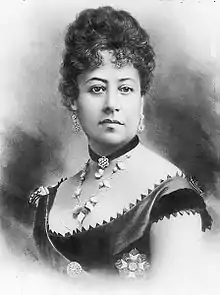 | |||||
| Queen consort of the Hawaiian Islands | |||||
| Reign | June 19, 1856 – November 30, 1863 | ||||
| Born | January 2, 1836 Honolulu, Oahu | ||||
| Died | April 25, 1885 (aged 49) Honolulu, Oahu | ||||
| Burial | May 17, 1885[1][2] Mauna ʻAla Royal Mausoleum | ||||
| Spouse | Kamehameha IV | ||||
| Issue | Albert Edward Kauikeaouli Kaleiopapa a Kamehameha | ||||
| |||||
| House | Kamehameha | ||||
| Father | High Chief George Naʻea Thomas Rooke (hānai) | ||||
| Mother | High Chiefess Fanny Kekelaokalani Young High Chiefess Grace Kamaʻikuʻi Young Rooke (hānai) | ||||
| Religion | Church of Hawaii | ||||
| Signature | |||||
Names
After her son's death and before her husband's death, she was referred to as "Kaleleokalani", or "flight of the heavenly one". After her husband also died, it was changed into the plural form as "Kaleleonālani", or the "flight of the heavenly ones". She was baptized into the Anglican faith on October 21, 1862 as "Emma Alexandrina Francis Agnes Lowder Byde Rooke Young Kaleleokalani.[3]
Queen Emma was also honoured in the 19th century mele "Wahine Holo Lio" (horseback riding lady) referring to her renowned horsemanship.[4]
Early life
Emma was born on January 2, 1836,[5] in Honolulu and was often called Emalani ("royal Emma"). Her father was High Chief George Naʻea and her mother was High Chiefess Fanny Kekelaokalani Young. She was adopted under the Hawaiian tradition of hānai by her childless maternal aunt, chiefess Grace Kamaʻikuʻi Young Rooke, and her husband, Dr. Thomas C. B. Rooke.[6]
Emma's father Naʻea was the son of High Chief Kamaunu and High Chiefess Kukaeleiki.[7] Kukaeleiki was daughter of Kalauawa, a Kauaʻi noble, and she was a cousin of Queen Keōpūolani, the most sacred wife of Kamehameha I. Among Naʻea's more notable ancestors were Kalanawaʻa, a high chief of Oʻahu, and High Chiefess Kuaenaokalani, who held the sacred kapu rank of Kekapupoʻohoʻolewaikala (so sacred that she could not be exposed to the sun except at dawn).[8]
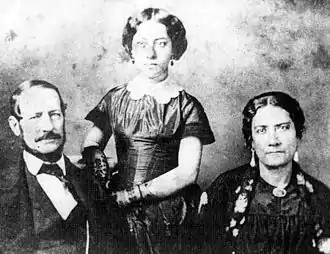
On her mother's side, Emma was the granddaughter of John Young, Kamehameha I's British-born military advisor known as High Chief Olohana, and Princess Kaʻōanaʻeha Kuamoʻo.[9][10] Her maternal grandmother, Kaʻōanaʻeha, was generally called the niece of Kamehameha I. Chiefess Kaʻōanaʻeha's father is disputed; some say she was the daughter of Prince Keliʻimaikaʻi, the only full brother of Kamehameha; others state Kaʻōanaʻeha's father was High Chief Kalaipaihala.[11][12] This confusion is due to the fact that High Chiefess Kalikoʻokalani, the mother of Kaʻōanaʻeha, married both to Keliʻimaikaʻi and to Kalaipaihala. Through High Chief Kalaipaihala, she could be descended from Kalaniʻopuʻu, King of Hawaii before Kīwalaʻō and Kamehameha. King Kalākaua and Queen Liliʻuokalani criticized Queen Emma's claim of descent from Kamehameha's brother, supporting the latter theory of descent. Liliʻuokalani claimed that Keliʻimaikaʻi had no children, and that Kiilaweau, Keliʻimaikaʻi's first wife, was a man.[13] This was to strengthen their claim to the throne, since their great-grandfather was Kamehameha I's first cousin. But even through the second theory Queen Emma would still have been descendant of Kamehameha I's first cousin since Kalaniʻopuʻu was the uncle of Kamehameha I.[14] It can be noted that one historian of the time, Samuel Kamakau, supported Queen Emma's descent from Keliʻimaikaʻi and the genealogy stated by Liliuokalani have been contested in her own lifetime.[15]
Emma grew up in her adoptive parents' English mansion, the Rooke House, in Honolulu. Emma was educated at the Royal School, which was established by American missionaries. Other Hawaiian royals attending the school included Emma's half-sister Mary Paʻaʻāina. Like her classmates Bernice Pauahi Bishop, David Kalākaua and Lydia Liliʻuokalani, Emma was cross-cultural — both Hawaiian and Euro-American in her habits. When the school closed, Dr. Rooke hired an English governess, Sarah Rhodes von Pfister, to tutor the young Emma. He also encouraged reading from his extensive library. As a writer, he influenced Emma's interest in reading and books. By the time she was 20, she was an accomplished young woman. She was 5' 2" and slender, with large black eyes. Her musical talents as a vocalist, pianist and dancer were well known. She was also a skilled equestrian.
Married life and reign
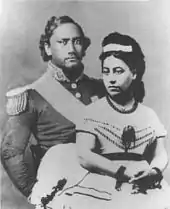
Emma became engaged to the king of Hawaii, Alexander Liholiho. At the engagement party, a Hawaiian charged that Emma's Caucasian blood made her unfit to be the Hawaiian queen and her lineage was not suitable enough to be Alexander Liholiho's bride; she broke into tears and the king was infuriated. On June 19, 1856, she married Alexander Liholiho, who a year earlier had assumed the throne as Kamehameha IV. He was also fluent in both Hawaiian and English. Each nation and even the Chinese hosted balls and celebrations in honor of the newlyweds. Two years later on May 20, 1858 Emma gave birth to a son, Prince Albert Edward Kamehameha.
The queen tended palace affairs, including the expansion of the palace library. In 1861 she sang in the chorus of a performance of Verdi's opera Il Trovatore in Honolulu while her husband the king acted as stage manager.[16] She was known for her humanitarian efforts. Inspired by her adoptive father's work, she encouraged her husband to establish a public hospital to help the Native Hawaiians who were in decline due to foreign-borne diseases like smallpox. In 1859, Emma established Queen's Hospital and visited patients there almost daily whenever she was in residence in Honolulu. It is now called the Queen's Medical Center. She also founded St. Andrewʻs Priory school for girls. Queen Emma recognized the educational needs of the young women of Hawaiʻi and founded St. Andrew's Priory so that Hawaiian girls would receive an education equivalent to what was traditionally offered only to boys.[17]
Prince Albert, who was always called "Baby" by Emma, had been celebrated for days at his birth and every public appearance. Mary Allen, wife of the Chief Justice of the Supreme Court Elisha Hunt Allen, had a son Frederick about the same age, and they became playmates. In 1862, Queen Victoria agreed to become godmother by proxy, and sent an elaborate silver christening cup. Before the cup could arrive, the prince fell ill in August and condition worsened. The Prince died on August 27, 1862. Her husband died a year later, and Emma would not have any more children.[18]
Religious legacy
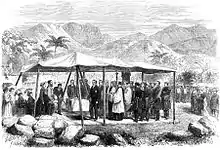
In 1860, Queen Emma and King Kamehameha IV petitioned the Church of England to help establish the Church of Hawaii. Upon the arrival of Anglican bishop Thomas Nettleship Staley and two priests, they both were baptized on October 21, 1862 and confirmed in November 1862. With her husband, she championed the Anglican (Episcopal) church in Hawaii and founded St. Andrew's Cathedral, raising funds for the building. In 1867 she founded Saint Andrew's Priory School for Girls.[19] She also laid the groundwork for an Episcopal secondary school for boys originally named for Saint Alban, and later ʻIolani School in honor of her husband. Emma and King Kamehameha IV are honored with a feast day of November 28 on the liturgical calendar of the U.S. Episcopal Church.[20][21]
Visit to Europe and United States, 1865–1866
From 1865 to 1866, she traveled to England and the United States for her health and to help the burgeoning Anglican mission in Hawaii. She visited London and spent the winter at Hyères in the French Rivera and then toured Northern Italy and Southern Germany before visiting Paris. She returned to London in June 1866 and went sightseeing in Ireland before sailing for New York. In her time in Europe, she met with Queen Victoria, Emperor Napoleon III, Empress Eugénie of France, Grand Duke Frederick II and Grand Duchess Louise of Baden and other Europeans royals, government dignitaries and Anglican clergy.[22]
In the United States, she had a reception given for her on August 14, 1866 by President Andrew Johnson and First Lady Eliza McCardle Johnson at the White House.[23][24] Some note this as the first time anyone with the title "Queen" had had an official visit to the U.S. presidential residence.[25] Secretary of State William H. Seward hosted the queen at his house and gave her state dinner on August 18. The following evening she attended a private dinner at the White House with the president, his family and Seward.[26] After visiting Washington, she visited Niagara Falls and Canada. The news of her hānai mother Grace's death in Hawaii on July 26 prompted her to end her trip and journey home. The United States government dispatched the USS Vanderbilt at San Francisco to bring her back to Honolulu.[23][27][28]
A pamphlet Queen Emma: A Narrative of the Object of Her Mission to England describing her travel and mission in England was published anonymously in London in December 1865.[29][30] American missionary Samuel C. Damon published this in his newspaper The Friend in June 1866 and pointed out some errors in the work.[29][31]
Royal election of 1874
After the death of King Lunalilo, Emma decided to run in the constitutionally-mandated royal election against future King Kalākaua. She claimed that Lunalilo had wanted her to succeed him, but died before a formal proclamation could be made.
The day after Lunalilo died, Kalākaua declared himself candidate for the throne. The next day Queen Emma did the same. The first real animosity between the Kamehamehas and Kalākaua begun to appear, as he published a proclamation:
To the Hawaiian Nation.
Salutations to You—Whereas His Majesty Lunalilo departed this life at the hour of nine o'clock last night; and by his death the Throne of Hawaii is left vacant, and the nation is without a head or a guide. In this juncture it is proper that we should seek for a Sovereign and Leader, and doing so, follow the course prescribed by Article 22nd of the Constitution. My earnest desire is for the perpetuity of the Crown and the permanent independence of the government and people of Hawaii, on the basis of the equity, liberty, prosperity, progress and protection of the whole people.
It will be remembered that at the time of the election of the late lamented Sovereign, I put forward my own claim to the Throne of our beloved country, on Constitutional grounds — and it is upon those grounds only that I now prefer my claims, and call upon you to listen to my call, and request you to instruct your Representatives to consider, and weigh well, and to regard your choice to elect me, the oldest member of a family high in rank in the country.
Therefore, I, David Kalakaua, cheerfully call upon you, and respectfully ask you to grant me your support.
D. KALAKAUA
Iolani Palace, Feb. 4, 1874.
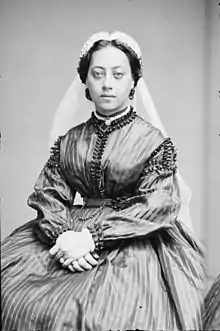
Queen Emma issued her proclamation the next day:
To the Hawaiian People:
Whereas, His late lamented Majesty Lunalilo died on the 3rd of February, 1874, without having publicly proclaimed a Successor to the Throne; and whereas, "His late Majesty did before his final sickness declare his wish and intention that the undersigned should be his Successor on the Throne of the Hawaiian Islands, and enjoined upon me not to decline the same under any circumstances; and whereas. "Many of the Hawaiian people have since the death of His Majesty urged me to place myself in nomination at the ensuing session of the Legislature; "Therefore, in view of the foregoing considerations and my duty to the people and to the memory of the late King, I do hereby announce and declare that I am a Candidate for the Throne of these Hawaiian Islands, and I request my beloved people throughout the group, to assemble peacefully ad orderly in their districts, and to give formal expression to their views on this important subject, and to instruct their Representatives in the coming session of the Legislature.
God Protect Hawaii!
Honolulu, Feb. 5, 1874.
EMMA KALELEONALANI.[32]
Emma's candidacy was agreeable to many Native Hawaiians, not only because her husband was a member of the Kamehameha Dynasty, but she was also closer in descent to Hawaii's first king, Kamehameha The Great, than her opponent. On foreign policy, she (like her husband) was pro-British while Kalākaua, although being pro-Hawaiian and somewhat pro-British, was more leaning toward the American. She also strongly wished to stop Hawaii's dependence on American industry and to give the Native Hawaiians a more powerful voice in government. While the people supported Emma, the Legislative Assembly, which actually elected the new monarch, favored Kalākaua, who won the election 39 – 6. News of her defeat caused a large-scale riot in which thirteen legislators supporting Kalākaua were injured; one, J. W. Lonoaea, ultimately died of his injuries.[33] In order to quell the civil disruption, American and British troops stationed on warships in Honolulu Harbor were landed with the permission of the Hawaiian government, and the rioters were arrested.[34]
After the election, she retired from public life. While she would come to recognize Kalākaua as the rightful king, she would never speak with his wife Queen Kapiʻolani.
She was known affectionately as the "Old Queen". King Kalākaua left a seat for her at any royal occasion, even though she rarely attended.
Friendship with Queen Victoria
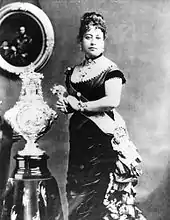
Despite the great differences in their kingdoms, Queen Emma and Queen Victoria became lifelong friends; both had lost sons and spouses.[23] They exchanged letters, and Emma met Victoria for the first time on September 9, 1865 on her trip to England and later spend a night at Windsor Castle on November 27.[35]
Queen Victoria recorded in her journal on the afternoon of September 9, 1865:
After luncheon I received Queen Emma, the widowed Queen of the Sandwich Islands or Hawaii. Met her in the Corridor & nothing could be nicer or more dignified than her manner. She is dark, but not more so than an Indian, with fine feathers [features?] & splendid soft eyes. She was dressed in just the same widow's weeds as I wear. I took her into the White Drawing room, where I asked to sit down next to me on the sofa. She was moved when I spoke to her of her great misfortune in losing her only child. She was very discreet & would only remain a few minutes. She presented her lady, Mrs. Hoopile whose husband is her Chaplain, both being Hawaiians....[36]
Death and legacy
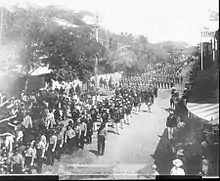
In 1883, Emma suffered the first of several small strokes and died two years later on April 25, 1885 at the age of 49.
At first she was laid in state at her house; but Alexander Cartwright and a few of his friends moved the casket to Kawaiahaʻo Church, saying her house was not large enough for the funeral. This was evidently not popular with those in charge of the church, since it was Congregational; Queen Emma had been a supporter of the Anglican Mission, and was an Episcopalian. Queen Liliʻuokalani said it "...showed no regard for the sacredness of the place". However, for the funeral service, Bishop Alfred Willis of the English Church officiated in the Congregational church with his ritual. She was given a royal procession and was interred in the Royal Mausoleum of Hawaii known as Mauna ʻAla, next to her husband and son.[37]
The Queen Emma Foundation was set up to provide continuous lease income for the hospital. Its landholding in the division known as the Queen Emma Land Company include the International Marketplace and Waikiki Town Center buildings.[38][39] Some of the 40 year leases expire in 2010.[40] The area known as Fort Kamehameha in World War II, the site of several coastal artillery batteries, was the site of her former beach-front estate. After annexation it was acquired by the U.S. federal government in 1907.[41]
The Emalani festival, Eo e Emalani i Alakaʻi held in October on the island of Kauaʻi in Koke'e State Park celebrates an 1871 visit.[42]
Honours
 Dame Grand Cross of the Most Noble Order of Kamehameha I (04/02/1879).
Dame Grand Cross of the Most Noble Order of Kamehameha I (04/02/1879).
Family tree
| Family tree |
|---|
See also
- Hānaiakamalama (Queen Emma Summer Palace)
- The Queen's Medical Center
References
- Rose, Conant & Kjellgren 1993, pp. 278–279.
- Forbes 2003, pp. 144–145.
- Kanahele 1999, p. 152.
- Kaeppler 1972, pp. 42–44.
- Kanahele 1999, p. 1.
- Kanahele 1999, pp. 1–4.
- McKinzie 1983, p. 73.
- Kanahele 1999, pp. 4–7.
- Apple 1978, pp. 39–41.
- Cahill 1999, p. 147.
- Kapiikauinamoku (June 20, 1955). "The Story of Maui Royalty: Princess Kamamalu Was Kamehamehaʻs Daughter". Honolulu Advertiser. Archived from the original on June 14, 2015. Retrieved January 1, 2010.
- Kapiikauinamoku (October 25, 1955). "The Story of Hawaiian Royalty: Princess Princess Kaoanaeha Is Married to John Young: The Kaleipaihala Controversy: 2". Honolulu Advertiser. Archived from the original on June 14, 2015. Retrieved March 5, 2010.
- Liliuokalani 1898, p. 404.
- Kanahele 1999, p. 357–358.
- Robert William Wilcox (May 27, 1898). "Some Geneology. R. W. Wilcox Corrects Statements in Ex-Queen's Book. Ancestry of Liliuokalani. Only Surviving Members of Royal School Destined to Be Rulers of Hawaii". Hawaiian Gazette. hdl:10524/3150.
- Junker, J. W. "Song of the Islands". Hana Hou!. Retrieved July 7, 2020.
- "History & Legacy – St. Andrew's Schools". www.standrewsschools.org. Archived from the original on December 1, 2017. Retrieved November 29, 2017.
- Hackler 1992, pp. 21–44.
- "St. Andrew's Priory School". official web site. Archived from the original on July 12, 2016. Retrieved January 29, 2010.
- The proper for the lesser Feasts and Fasts (Church Publishing Company, 2003)
- The Book of common prayer and administration of the sacraments and other rites and ceremonies of the church. Church Publishing, Incorporated, New York. 1979. p. 29. ISBN 978-0-89869-060-6. Archived from the original on May 6, 2016. Retrieved November 22, 2015.
- Kanahele 1999, pp. 189-226.
- Kanahele 1999, pp. 189–226.
- Esther Singleton (1907). The story of the White House, Volume 2. The McClure Company. p. 109. Archived from the original on June 3, 2016. Retrieved November 22, 2015.
- Steven Anzovin; Janet Podell (2001). Famous first facts about American politics. H.W. Wilson. p. 136. ISBN 978-0-8242-0971-1. Archived from the original on May 20, 2016. Retrieved November 22, 2015.
- Seward & Seward 1891, pp. 333–337.
- Kuykendall 1953, p. 205.
- Papers relating to the foreign relations of the United States: transmitted to Congress with the Annual message of the President. 1866. Washington, DC: US Government Print Office. 1867. pp. 490, 491, 494, 495, 498.
- Forbes 2001, p. 398.
- "Queen Emma. A Narrative of the Object of Her Mission to England". The Era. London. December 31, 1865. p. 9.
- Damon, Samuel C. (June 1, 1866). "Queen Emma's Visit to England and Reprint of Queen Emma: A Narrative of the Object of Her Mission to England" (PDF). The Friend. 23 (6). Honolulu: Samuel C. Damon. pp. 41–44.
- Kanahele 1999, p. 283.
- Dabagh, Lyons & Hitchcock 1974, pp. 76–89.
- Kuykendall 1967, pp. 9–11; Kanahele 1999, pp. 288–292; Osorio 2002, pp. 154–157; Kaeo & Queen Emma 1976, pp. 165–166
- Hackler 1988, pp. 109–112.
- Kanahele 1999, pp. 199–200.
- Liliuokalani 1898, pp. 108–109.
- Janis L. Magin (September 24, 2008). "New plan for International Market Place announced". Pacific Business News (Honolulu).
- "Queen Emma Kaleleonalani". International Market Place and Waikiki Town Center web site. Queen Emma Land Company. Archived from the original on August 3, 2013. Retrieved February 1, 2010.
- Allison Schaefers (May 19, 2009). "Queen Emma has tract ideas: No agreement could be reached on the Waikiki land parcel". Honolulu Star-Bulletin. Archived from the original on May 24, 2009. Retrieved March 2, 2010.
- Gregg K. Kakesako (October 27, 1997). "Fort Kamehameha looks nothing like it did in 1920: The post used to guard Pearl Harbor's entrance but is now part of Hickam". Honolulu Star-Bulletin. Archived from the original on November 12, 2011. Retrieved February 1, 2010.
- "Eo e Emalani i Alaka'i — The Emalani Festival". Hui o Laka, Kōkeʻe Museum. Archived from the original on July 4, 2010. Retrieved February 1, 2010.
Bibliography
- Allen, Helena G. (1982). The Betrayal of Liliuokalani: Last Queen of Hawaii, 1838–1917. Glendale, CA: Arthur H. Clark Company. ISBN 978-0-87062-144-4. OCLC 9576325.
- Apple, Russel A. (1978). "Appendix A: Young Family Geneology". Pahukanilua: Homestead of John Young: Kawaihae, Kohala, Island of Hawaiʻi : Historical Data Section of the Historic Structure Report. Honolulu: National Park Office, Hawaii State Office. pp. 39–41. OCLC 4962701.
- Cahill, Emmett (1999). The Life and Times of John Young: Confidant and Advisor to Kamehameha the Great. Aiea HI: Island Heritage Publishing. ISBN 978-0-89610-449-5. OCLC 42656570.
- Cooke, Amos Starr; Cooke, Juliette Montague (1937). Richards, Mary Atherton (ed.). The Chiefs' Children School: A Record Compiled from the Diary and Letters of Amos Starr Cooke and Juliette Montague Cooke, by Their Granddaughter Mary Atherton Richards. Honolulu: Honolulu Star-Bulletin. OCLC 1972890.
- Cracroft, Sophia; Franklin, Jane; Queen Emma (1958). Korn, Alfons L. (ed.). The Victorian Visitors: An Account of the Hawaiian Kingdom, 1861–1866, Including the Journal Letters of Sophia Cracroft: Extracts from the Journals of Lady Franklin, and Diaries and Letters of Queen Emma of Hawaii (PDF). Honolulu: University of Hawaii Press. hdl:10125/39981. ISBN 978-0-87022-421-8. OCLC 8989368.
- Dabagh, Jean; Lyons, Curtis Jere; Hitchcock, Harvey Rexford (1974). Dabagh, Jean (ed.). "A King is Elected: One Hundred Years Ago" (PDF). The Hawaiian Journal of History. Honolulu: Hawaiian Historical Society. 8: 76–89. hdl:10524/112. OCLC 60626541.
- Forbes, David W., ed. (2001). Hawaiian National Bibliography, 1780–1900, Volume 3: 1851–1880. 3. Honolulu: University of Hawaii Press. ISBN 978-0-8248-2503-4. OCLC 123279964.
- Forbes, David W., ed. (2003). Hawaiian National Bibliography, 1780–1900, Volume 4: 1881–1900. 4. Honolulu: University of Hawaii Press. ISBN 978-0-8248-2636-9. OCLC 123279964.
- Haley, James L. (2014). Captive Paradise: A History of Hawaii. New York: St. Martin's Press. ISBN 978-0-312-60065-5. OCLC 865158092.
- Hackler, Rhoda E. A. (1988). ""My Dear Friend": Letters of Queen Victoria and Queen Emma". The Hawaiian Journal of History. Honolulu: Hawaiian Historical Society. 22: 101–130. hdl:10524/202. OCLC 60626541.
- Hackler, Rhoda E. A. (1992). "Albert Edward Kauikeaouli Leiopapa a Kamehameha, Prince of Hawai'i". The Hawaiian Journal of History. Honolulu: Hawaiian Historical Society. 26: 21–44. hdl:10524/349. OCLC 60626541.
- Inglis, Kerri A. (2013). Ma'i Lepera: A History of Leprosy in Nineteenth-Century Hawai'i. Honolulu, HI: University of Hawaii Press. ISBN 978-0-8248-6579-5.
- Kaeo, Peter; Queen Emma (1976). Korn, Alfons L. (ed.). News from Molokai, Letters Between Peter Kaeo & Queen Emma, 1873–1876. Honolulu: The University Press of Hawaii. hdl:10125/39980. ISBN 978-0-8248-0399-5. OCLC 2225064.
- Kam, Ralph Thomas (2017). Death Rites and Hawaiian Royalty: Funerary Practices in the Kamehameha and Kalakaua Dynasties, 1819–1953. S. I.: McFarland, Incorporated, Publishers. ISBN 978-1-4766-6846-8. OCLC 966566652.
- Kamakau, Samuel (1992) [1961]. Ruling Chiefs of Hawaii (Revised ed.). Honolulu: Kamehameha Schools Press. ISBN 0-87336-014-1. OCLC 25008795.
- Kanahele, George S. (1999). Emma: Hawaii's Remarkable Queen. Honolulu: University of Hawaii Press. ISBN 978-0-8248-2240-8. OCLC 40890919.
- Kanahele, George S. (2002) [1986]. Pauahi: The Kamehameha Legacy. Honolulu: Kamehameha Schools Press. ISBN 978-0-87336-005-0. OCLC 173653971.
- Kaeppler, Adrienne L. (1972). "Acculturation in Hawaiian Dance". Yearbook of the International Folk Music Council. Cambridge University Press. 4: 42–44. doi:10.2307/767671. JSTOR 767671. Retrieved October 22, 2020.
- Kuykendall, Ralph Simpson (1953). The Hawaiian Kingdom, 1854–1874, Twenty Critical Years. 2. Honolulu: University of Hawaii Press. ISBN 978-0-87022-432-4.
- Kuykendall, Ralph Simpson (1967). The Hawaiian Kingdom 1874–1893, The Kalakaua Dynasty. 3. Honolulu: University of Hawaii Press. ISBN 978-0-87022-433-1. OCLC 500374815.
- Law, Anwei Skinsnes (2012). Kalaupapa: A Collective Memory (Ka Hokuwelowelo). Honolulu: University of Hawaii Press. ISBN 978-0-8248-6580-1. OCLC 830023588.}
- Liliuokalani (1898). Hawaii's Story by Hawaii's Queen, Liliuokalani. Boston: Lee and Shepard. ISBN 978-0-548-22265-2. OCLC 2387226.
- Lydecker, Robert Colfax, ed. (1918). Roster Legislatures of Hawaii, 1841–1918. Honolulu: Hawaiian Gazette Company. OCLC 60737418.
- McKinzie, Edith Kawelohea (1983). Stagner, Ishmael W. (ed.). Hawaiian Genealogies: Extracted from Hawaiian Language Newspapers. 1. Honolulu: University of Hawaii Press. ISBN 0-939154-28-5. OCLC 12555087.
- McKinzie, Edith Kawelohea (1986). Stagner, Ishmael W. (ed.). Hawaiian Genealogies: Extracted from Hawaiian Language Newspapers. 2. Honolulu: University of Hawaii Press. ISBN 978-0-939154-37-1. OCLC 12555087.
- Osorio, Jon Kamakawiwoʻole (2002). Dismembering Lāhui: A History of the Hawaiian Nation to 1887. Honolulu: University of Hawaii Press. ISBN 978-0-8248-2549-2. OCLC 48579247.
- Parker, David "Kawika" (2008). "Crypts of the Ali`i The Last Refuge of the Hawaiian Royalty". Tales of Our Hawaiʻi (PDF). Honolulu: Alu Like, Inc. OCLC 309392477. Archived from the original (PDF) on November 11, 2013.
- Peterson, Barbara Bennett, ed. (1984). Notable Women of Hawaii. Honolulu: University of Hawaii Press. ISBN 978-0-8248-0820-4. OCLC 11030010.
- Pratt, Elizabeth Kekaaniauokalani Kalaninuiohilaukapu (1920). History of Keoua Kalanikupuapa-i-nui: Father of Hawaii Kings, and His Descendants, with Notes on Kamehameha I, First King of All Hawaii. Honolulu: Honolulu Star-Bulletin. OCLC 154181545.
- Restarick, Henry Bond (1924). Hawaii, 1778–1920, from the Viewpoint of a Bishop: Being the Story of English and American Churchmen in Hawaii with Historical Sidelights. Honolulu: Paradise of the Pacific. OCLC 1337282.
- Rose, Roger G.; Conant, Sheila; Kjellgren, Eric P. (September 1993). "Hawaiian Standing Kāhili in the Bishop Museum: An Ethnological and Biological Analysis". Journal of the Polynesian Society. Wellington, NZ: Polynesian Society. 102 (3): 273–304. JSTOR 20706518.
- Rossi, Pualiʻiliʻimaikalani (December 2013). "No Ka Pono ʻOle O Ka Lehulehu: The 1874 Election of Hawaiʻi's Moʻi And The Kanaka Maoli Response" (PDF). Honolulu: University of Hawaii at Manoa. hdl:10125/100744. Cite journal requires
|journal=(help) - Seward, William Henry; Seward, Frederick William (1891). Autobiography of William H. Seward, from 1801 to 1834: With a Memoir of His Life, and Selections from His Letters from 1831 to 1846. New York: D. Appleton and Company. pp. 333–337. OCLC 4112122.
- Tsai, Tiffany Ing (2016). "The 1873 Election in Hawaiʻi between Prince William Charles Lunalilo and the Other Candidate". The Hawaiian Journal of History. Honolulu: Hawaiian Historical Society. 50 (50): 53–73. doi:10.1353/hjh.2016.0002. hdl:10524/59459. OCLC 60626541. S2CID 164663327 – via Project MUSE.
- Van Dyke, Jon M. (2008). Who Owns the Crown Lands of Hawaiʻi?. Honolulu: University of Hawaii Press. ISBN 978-0-8248-6560-3. OCLC 257449971 – via Project MUSE.
- Zambucka, Kristin (1977). The High Chiefess: Ruth Keelikolani. Honolulu: Mana Publishing Company. OCLC 3836213.
- Zambucka, Kristin (2002). Kalakaua: Hawaiʻi's Last King. Honolulu: Māna Publishing Company. ISBN 978-0-931897-04-7. OCLC 123305738.
Further reading
- A. I. (1866). Queen Emma: A Narrative of the Object of Her Mission to England (Second ed.). London. OCLC 1062251450.
- Benton, Russell E. (1988). Emma Naea Rooke (1836–1885), Beloved Queen of Hawaii. Vol. 5, Mellen Studies in History. Lewiston, NY: E. Mellen Press. ISBN 978-0-88946-039-3. OCLC 1016183512.
- Bray, David Kaonohiokala; Low, Douglas (1990). The Kahuna Religion of Hawai'i. Garberville, CA: Borderland Sciences & Research Foundation, Inc. ISBN 978-0-945685-05-0. OCLC 25599949.
- Dabagh, Jean; Lyons, Curtis Jere; Hitchcock, Harvey Rexford (1974). Dabagh, Jean (ed.). "A King is Elected: One Hundred Years Ago" (PDF). The Hawaiian Journal of History. Honolulu: Hawaiian Historical Society. 8: 76–89. hdl:10524/112. OCLC 60626541.
- Harper's Weekly (August 19, 1865). "Emma, Queen Dowager of Hawaii". Harper's Weekly, A Journal of Civilization. New York: Harper & Brothers. IX (451): 513, 518.
- Harper's Weekly (August 25, 1866). "Queen Emma in America". Harper's Weekly, A Journal of Civilization. New York: Harper & Brothers. X (504): 533, 541–542.
- Ing, Tiffany Lani (2019). Reclaiming Kalākaua: Nineteenth-Century Perspectives on a Hawaiian Sovereign. Honolulu: University of Hawaii Press. ISBN 978-0-8248-8156-6. OCLC 1085155006.
- Kalākaua, David (1888). Daggett, Rollin Mallory (ed.). The Legends and Myths of Hawaii: The Fables and Folk-lore of a Strange People. New York: C.L. Webster & Company. OCLC 1036300398.
- Korn, Alfons L.; Peterson, Barbara Bennett (2003). Emalani: Queen Emma Kaleleonālani. Honolulu: [[Daughters of Hawaii]] Publications Committee. ISBN 978-0-938851-14-1. OCLC 243602254.
- Mackenzie, Anne, ed. (1866). Hawaiian Mission. The Net: Cast In Many Waters: Sketches From The Life Of Missionaries of 1866. London: Lothian & Co. pp. 10–13, 17–24, 39–43, 57–60, 87–95, 123–128, 161–167.
- Manuscript No. M-45, Queen Emma Collection Finding Aid (PDF). Hawaii State Archives.
- Obermer, Nesta; Larsen, Paul (1960). E Ola o Emmalani (Queen Emma speaks). Honolulu: The Queen's Hospital. OCLC 16332758.
- Pukui, Mary Kawena; Elbert, Samuel H. (1986). Hawaiian Dictionary: Hawaiian-English, English-Hawaiian. Honolulu: University of Hawaii Press. ISBN 978-0-8248-0703-0. OCLC 12751521.
- Queen Emma (2001). He lei no ʻEmalani. Translated by Puakea Nogelmeier. Honolulu: Queen Emma Foundation, Bishop Museum Press. ISBN 978-1-58178-009-3. OCLC 46991952.
- Queen Emma (2017). Forbes, David W. (ed.). In Haste with Aloha: Letters and Diaries of Queen Emma, 1881–1885. Honolulu: University of Hawaii Press. ISBN 978-0-8248-5783-7. JSTOR j.ctvvmzwx. OCLC 1002258964.
- Rappolt, Miriam E. (1990). Queen Emma: A Woman of Vision. Kailua, HI: Press Pacifica. ISBN 978-0-916630-68-3. OCLC 2270748.
- Volkmar, Janine S. (1987). A Selected Bibliography on Queen Emma. Honolulu: Paper, University of Hawaii, Hamilton Library. OCLC 663423771.
- Walker, Jerry; Ahlo, Charles; Johnson, Rubellite Kawena (2016) [2000]. Kamehameha's Children Today. Honolulu: Native Books, Inc. ISBN 978-0-9967803-0-8. OCLC 1035718896.
External links
| Wikisource has original text related to this article: |
| Wikimedia Commons has media related to Queen Emma of Hawaii. |
- Jeffrey Bingham Mead (March 9, 2011). "Japanese Bow to Queen Emma, Western Women and Hoop Skirts in Hawaii". 1860: Japanese Embassy to America Visits Hawaii. Retrieved July 5, 2015.
- "Biography of Founder Queen Emma". The Queen's Medical Center. Retrieved December 30, 2009.
- Jessica from Pukalani. "Woman Hero: Queen Emma". My Hero web site. Retrieved February 1, 2010.
- Will Hoover (July 2, 2006). "Queen Emma". The Honolulu Advertiser. Retrieved February 1, 2010.
- Emma Kaleleonalani at Find a Grave
- Laurie Schoonmaker. "Thoughts of a Queen". Horizons 2001. Kapiolani Community College. Archived from the original on June 9, 2010. Retrieved February 1, 2010.
- James Kiefer (October 1, 2009). "King Kamehameha and Queen Emma of Hawaii (28 NOV 1864)". The Lectionary: A collection of Lectionary resources for the Episcopal Church.
| Royal titles | ||
|---|---|---|
| Preceded by Kalama |
Queen consort of Hawaiʻi 1856–1863 |
Succeeded by Kapiʻolani |